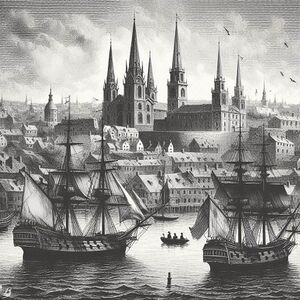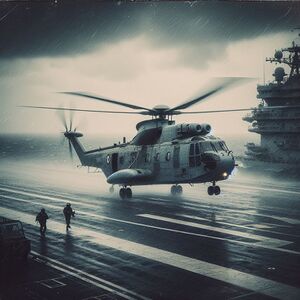Structure of the Royal Arcerion Naval Service
The Structure of the Royal Arcerion Naval Service consists of multiple branches, those being: The Admiralty, Naval Operations Branch, Shore Establishment, and the Fleet.

The organization of the Navy has changed over the centuries and gradually evolved to its current state after the end of the Occidental Cold War and following the Final War of the Deluge. During the First and Second Great Wars, it was organized along the Ardmori tradition, which centred around Battleship, Cruiser, and Destroyer divisions which was each composed of squadrons of ships of the named class. However the end of the Occidental Cold War, and the closer defense relationship with Burgundie has gradually evolved the structure of the Navy towards the Task Force system wherein shops are administratively controlled by squadrons or flotillas, but functionally and operationally assigned to combatant commanders in Task Forces dedicated for a certain mission or operation. By the 1990s and early 2000s, this was the norm and the creation of a Burgoignesc surface warfare school to be attended by Arcer naval officers furthered the changes in doctrine that shaped the changes in the Naval Service.
In modern times, the structure of the Navy can be considered to have the traditions, heraldry, and historical lineage of the Ardmori Navy, but functionally it functions as an offshoot of Burgoignesc naval doctrine and practices.
History

Early Arcer naval organization was a subset of Ardmore's Royal Navy. The ships were assigned to the Arcerion Squadron, the first fledgling formation for warships in the then Ardmore colony of Arcerion. These were joined in conjunction by 'stone ships,' or the shore facilities and ports with naval berthings that supported the actual wooden ships and frigates throughout the end of the 18th century. These forts had shore batteries of naval guns that both protected harbours, such as Kurst and Chester-on-Moore, as well as strategic choke points such as the Warrington Straits or the Innis River Basin. These early institutions would eventually become the nascent beginning of the Royal Arcerion Naval Service.
The Royal Arcerion Naval Service, after its establishment in 1805 organized itself around two squadrons of wooden frigates, as it had no ships-of-the-line (battleships). These two squadrons were each commanded by a Commodore, with a Rear Admiral in command. Concurrently, the shore facilities were also commanded by a Rear Admiral, with overall command of the Arcer Navy as a Vice Admiral. During this period, up until the dissolution of the Ardmore Crown during the Ardmori Civil War, Arcerion would remain under the command of the Ardmori Admiralty. During this period, the Arcer Navy would reorganize into multiple new squadrons. Notably, the Songun and Malentine Squadrons would comprise the initial battle line of the Arcer Navy, numbering roughly a dozen warships. As well, the Riverine Squadron was created to sail a number of the large rivers in Arcerion, as well as organizing a Seaman's School and a Naval Officer Academy in Chester-on-Moore.
By the end of 1800, the Arcer Navy required restructuring due to the number of forts, naval shore batteries, warships, and a growing Admiralty. The establishment of the Arcer Admiralty (eventually amalgamated into the Arcer General Staff) also meant that there had to be a fundamental restructuring of the naval messes and officer education, as most Arcer senior officers were former Ardmori naval officers that had emigrated to Arcerion and used their discharge papers to receive parcels of land from the Arcer Colonial Government and the Crown Governor of Arcerion.
With the introduction of modern per-dreadnought warships, Arcerion also had a major shift in its naval structure during the Ardmori Civil War. With the destruction and dissolution of both the Ardmori Royal Navy as well as the lack of overall command, the Arcer Admiralty reorganized their navy to accomodate the fact that they were now a sovereign nation and not a functional part of the Ardmori Armed Forces. During this period, described as the post-Sovereign period in the Navy's official history, there was a tumultuous amount of change. The Ardmori tradition for the Navy was kept, espcially with regards to the ranks and organization. During this period collaboration began with the Burgoignesc Navy, which would eventually become the Arcer Navy's major partner.
The Ardmori Civil War also identified the need for a dedicated Merchant Marine and a sealift command. The Arcer Ardmiralty created a dedicated transport and supply organization to ensure that men, weapons, and equipment could be sent overseas for expeditionary operations. This was also the period that Arcer doctrine suffered heavily as the Ardmori Navy had traditionally been the blue and green water expertise that Arcerion lacked. However, the large amount of Ardmori expats and the Ardmori diaspora helped as many former members of the Ardmori Navy joined the Arcer Naval Service upon arriving in the colony.
1GW
interwar
2GW
cold war
modern mini burg navy
Administrative
The Admiralty (Headquarters)

The Arcer Admiralty, based out of Kurst, forms the senior headquarters for the Naval Service. It is comprised of senior naval officers, sometimes referred to as Flag Officers, senior enlisted rates, as well as civilian public servants and contractors. The Admiralty is part of the larger Arcer General Staff, and functions as the main operations and directive role for the Navy. It creates doctrine, staffs large departmental changes, manages the procurement of new naval vessels, promotes and controls the careers of sailors and officers, as well as creates the educational and training requirements for the Naval Service. The Admiralty in recent years has seen an increased level of senior officer exchanges with the Burgoignesc Navy.
The Naval Operations Branch, sometimes referred to as the Naval Affairs Office, is the civilian and public service branch of the Royal Arcerion Naval Service. It manages the major capital procurement, systems upgrades, IT management, finances, and background logistical activities such as human resources and personnel management for the Navy.
Shore Establishment
Staff College - Chester
Basic training facilities - Chester
The Fleet
The Fleet, also known as the Fleet Command, is the administrative headquarters and command element for all of the warships, support vessels, and aircraft of the Royal Arcerion Naval Service. Within the Fleet, it is separated into multiple components depending on their function, operational role, or composition. The sub-components of the Fleet are: Theatre Commands, Naval Air Arm, Support Command, and the Raiding Command. The Theatre Commands represent the administrative headquarters for Task Forces of warships and on occasion, submarines, around Ixnay. The Theatre Commands are organized into four distinct groupings, those being the Malentine and Songun Seas, the Polynesian Sea (including St. Brendan's Strait) and lastly the Arctic Command (including the Western Odoneru Ocean and Albion Sea). The Malentine Command is based out of Port Gibson in Foxhey Governorate, and its sister command the Songun is based out of Chester-on-Moore, in Moorden Governorate. The most relevant modern command, the Polynesian Command is based out of the Southampton Yards at Joint Naval Station Daniel Launtceur. Lastly, the Arctic Command is based out of Port Northford in Howland Governorate.

The Naval Air Arm is the main aerial warfare component for the Naval Service. It is primarily made up of four kinds of aircraft, spanning numerous types. The primary warfighting function for the Naval Air Arm is the Naval Air Squadrons that are aboard Arcerion's only fleet carrier, the Kurst. These are made up of Aeroco Kestrels of the 'M' or maritime variant. Supporting these are the maritime patrol aircraft of the air force, also organized into Naval Air Squadrons. These maritime patrol aircraft are fixed-wing aicraft that are designed and equipped for long duration flights over water, primarily conducting anti-submarine warfare (ASW), anti-ship warfare (AShW) and in some cases, supporting Search and Rescue. The third kind of aircraft employed by the Naval Air Arm are rotor wing helicopters that launch and are recovered from the frigates, corvettes and other ships of the Naval Service. Lastly, there are specialty squadrons of drones and other unmanned systems that are more newly introduced to the Naval Air Arm.
The third command within the Fleet is the Support Command. The Support command is largely comprised of the following sub-components: logistics, shore faciltiies (shared with the Shore Establishment), Radar & Early Warning, Staff & Training, Sealift and Transport Command. Within the Support command, the Sealift and Transportation vessels are the most visible and notable, as they carry the men, weapons, equipment, supplies and humanitarian aid around the globe to support the government of Arcerion and the Arcerion Armed Forces.
Lastly, the Raiding Command is a bespoke and unique sub-component as no other organization exists like it in Ixnay. The Raiding Command is comprised of a mixture of mine warfare vessels, intelligence gathering vessels, as well as the maritime special forces of Arcerion, the Marine Commandos. Under the Raiding Command the Royal Arcerion Submarine Service is administratively managed.
Cronan Bases
Submarines
Frigates/Destroyers
Maritime patrol
SAR
Main naval base
major yards
destroyers, frigates, expeditionary support vessels
maritime patrol
SAR
Overseas Bases
Kurst battlegroup
Planned Base in Republic of Stenza
Formations
Surface squadrons
Air squadrons
Submarines
Special Forces
Radar and AWACS